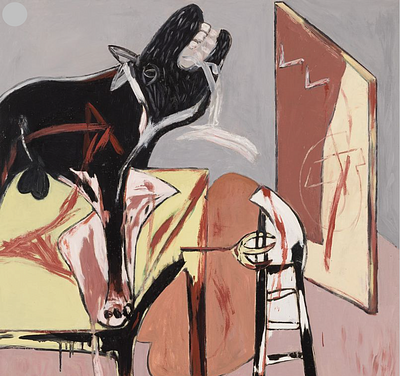JOAQUÍN TORRES GARCÍA (Montevideo, Uruguay, 1874 - 1949). "Fructus espiritus". Pencil on paper. Attached Certificate of the Torres García Foundatio
Lot 105
About Seller
Setdart Auction House
Carrer Aragó 346
Barcelona
Spain
Setdart Subastas was born in 2004 and is currently the first online art auction in Spain with solidity, prestige and reliability guaranteed by our more than 60,000 users. Setdart has a young, dynamic and enterprising team ready to successfully manage the purchase and sale of art works through custom...Read more
Categories
Estimate:
EUR€7,000 - EUR€8,000
$7,291.67 - $8,333.33
Absentee vs Live bid
Two ways to bid:
- Leave a max absentee bid and the platform will bid on your behalf up to your maximum bid during the live auction.
- Bid live during the auction and your bids will be submitted real-time to the auctioneer.
Bid Increments
| Price | Bid Increment |
|---|---|
| EUR€0 | EUR€10 |
| EUR€200 | EUR€25 |
| EUR€500 | EUR€50 |
| EUR€1,000 | EUR€100 |
| EUR€3,000 | EUR€200 |
| EUR€5,000 | EUR€500 |
| EUR€10,000 | EUR€1,000 |
| EUR€20,000 | EUR€2,000 |
| EUR€50,000 | EUR€5,000 |
About Auction
By Setdart Auction House
Nov 16, 2021
Set Reminder
2021-11-16 08:00:00
2021-11-16 08:00:00
America/New_York
Bidsquare
Bidsquare : Contemporary and Actual Art
https://www.bidsquare.com/auctions/setdart-auction-house/contemporary-and-actual-art-7839
Setdart Auction House sofia@setdart.com
Setdart Auction House sofia@setdart.com
- Lot Description
JOAQUÍN TORRES GARCÍA (Montevideo, Uruguay, 1874 - 1949). "Fructus espiritus". Pencil on paper. Attached Certificate of the Torres García Foundation, 1990. Measurements: 16.5 x 13 cm; 38 x 35 cm (frame). After beginning his training as a self-taught artist, in 1890 Torres García decided to emigrate in order to train as a painter. He travels to Europe with his family the following year, at the age of seventeen. In 1892 he settled in Barcelona and entered the School of Fine Arts. There he came into contact with French impressionism, the main influence at that time for him and other famous students, such as Mir, Sunyer, Canals and Nonell. He combined this school with classes at the Baixas Academy, the most reputable at the time. From 1894 he participated in the General Exhibitions of Fine Arts, in the foreign section. During this decade he published several drawings in newspapers and magazines such as "La Vanguardia", "Iris", "Barcelona Cómica" or "La Saeta". In 1901 he began to paint in fresco, attracted by the timeless spirit of the ancient works made in this technique, and entered a dynamic group work in which painters, musicians, sculptors and poets collaborated. Years later he traveled to Italy to perfect his knowledge of this discipline. He also worked in decoration, a field in which his collaboration with Antoni Gaudí in the cathedral of Palma de Mallorca stands out. Around 1910 he began to introduce formal elements typical of Catalonia into his work, imbued with the spirit of vindication of the Catalan identity of the time. Several official commissions are related to this new approach, among which the mural decoration of the Salón de Sant Jordi at the headquarters of the Diputación Provincial de Barcelona stands out as a turning point in his career. In 1920 he moved to New York and came into contact with artists of the stature of Max Weber, Man Ray and Marcel Duchamp. Soon after he returned to Europe and settled in Paris, where he frequented the meetings of the group led by Mondrian, thus approaching abstraction and constructivism. In 1934 he finally decided to return to Montevideo, where he was received as a member of the European artistic elite. There he creates the Society of the Arts of Uruguay, whose aim was to integrate all the arts and act as a link between artists and the public. He came into contact with pre-Columbian and indigenous Uruguayan art, and this aesthetic, new to him, would have a crucial influence on his thinking. He claimed that artists did not need to renounce being Latin American by pretending to be contemporary, and he brought a new dimension to the construction of the modern American language. Moreover, from this moment on, the cultural symbology of his own land took on a decisive importance in his work. His work is preserved in the Thyssen-Bornemisza Museum, the Modern Art Museums of New York, San Francisco and Lille, the Reina Sofia National Museum, the National Art Museum of Catalonia, the Torres Garcia Museum of Montevideo, the Fine Arts Museums of Houston, Philadelphia and Santa Barbara, the National Museum of Fine Arts of São Paulo, the Hirshhorn and Art of the Americas Museums of Washington DC, the Albright-Knox Gallery of Buffalo and the Los Angeles County Museum, among others.
- Shipping Info
-
In-house shipping available. Please inquire at admin@setdart.com.
-
- Buyer's Premium



 EUR
EUR CAD
CAD AUD
AUD GBP
GBP MXN
MXN HKD
HKD CNY
CNY MYR
MYR SEK
SEK SGD
SGD CHF
CHF THB
THB














